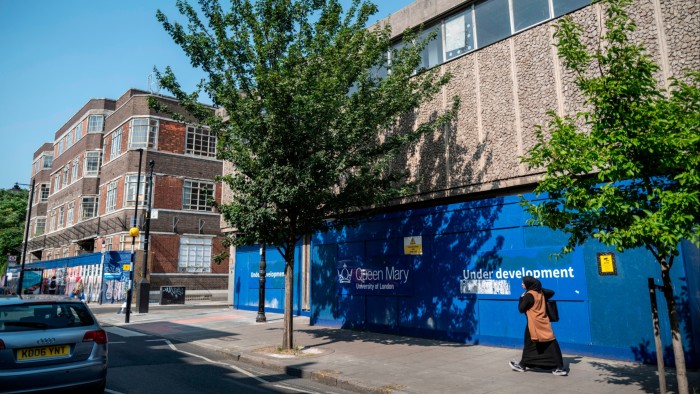Stay informed with free updates
Simply sign up to the Health sector myFT Digest — delivered directly to your inbox.
Queen Mary University of London is to develop a large biomedical campus in a deprived part of the East End, after signing a deal with the government to buy 80,000 sq m of land alongside its existing Whitechapel campus.
Colin Bailey, Queen Mary’s principal, estimated that development of the largely derelict site into a world-class life sciences centre would cost about £750mn, which the university would fund in partnership with the private and public sector.
Although many UK universities are showing signs of financial stress, “Queen Mary’s good financial position enables us to make a major investment for the long-term future of our university and our mission,” Bailey said.
The Whitechapel site last changed hands in 2016 when Barts Health NHS Trust sold it to the Department of Health and Social Care for £77mn.
One person close to the deal said the new purchase price would be within a few million pounds of the 2016 deal. Queen Mary and DHSC declined to disclose details of the transaction.
“We will build on Queen Mary’s unparalleled position as a university that combines high-quality research and education with a profound commitment to the local communities we serve and to addressing health and social inequalities,” Bailey said.
The site is on the south side of Whitechapel Road next to the Royal London Hospital. Bailey said Queen Mary “is paying the open market rate for the land. We haven’t got a special deal from DHSC”.
“Any substantial London development site with potential/planning for life sciences use is likely to have increased in value,” said Mark Pickering, director of Property Data, which provides property market analysis.
The plans will include five new and repurposed buildings designed by architects Allies & Morrison and Gibson Thornley. The local authority, Tower Hamlets, gave planning consent last November.
Sir Mark Caulfield, Queen Mary’s vice-principal for health, said the funding came from the university’s “strategic reserve funds”.
“This is a once-in-several-lifetimes opportunity for Queen Mary. If we let it pass, there is no other estate adjacent to any of our campuses likely to become available to the university,” he added. “You have to take a calculated risk at times and we’re taking it from a position of confidence.”
London’s life sciences facilities are growing rapidly, from White City in the west, across the so-called Knowledge Quarter around King’s Cross and Bloomsbury and out to Canary Wharf in the east.
By 2030, the capital will have an additional 580,000 sq m of lab and office space dedicated to life sciences, the Grow London initiative said this year.
Queen Mary could compete with other biomedical campuses, Caulfield said. “As a university we can provide the infrastructure that small and medium-sized enterprises don’t have. We have the NHS nearby, with Barts Health running five hospitals and the highest number of patients enrolled in commercial trials in the country.
“We’ll be working very closely with Tower Hamlets, Barts Health and other partners to maximise the benefit to patients in one of the most deprived parts of the country,” he added.




